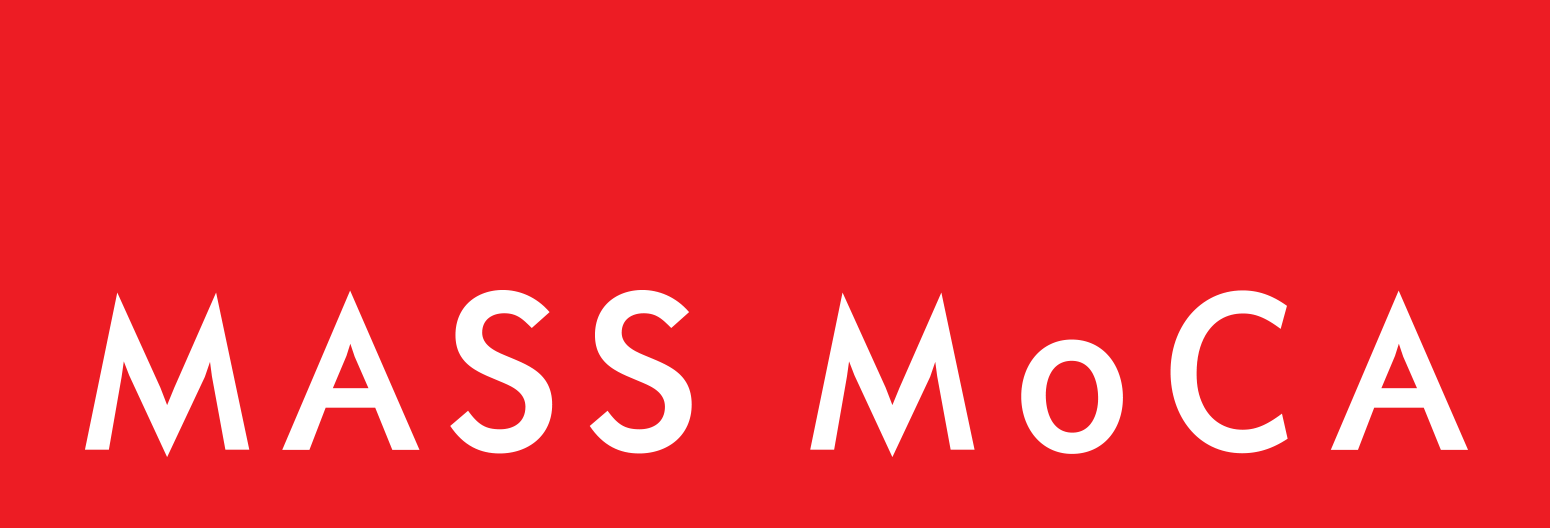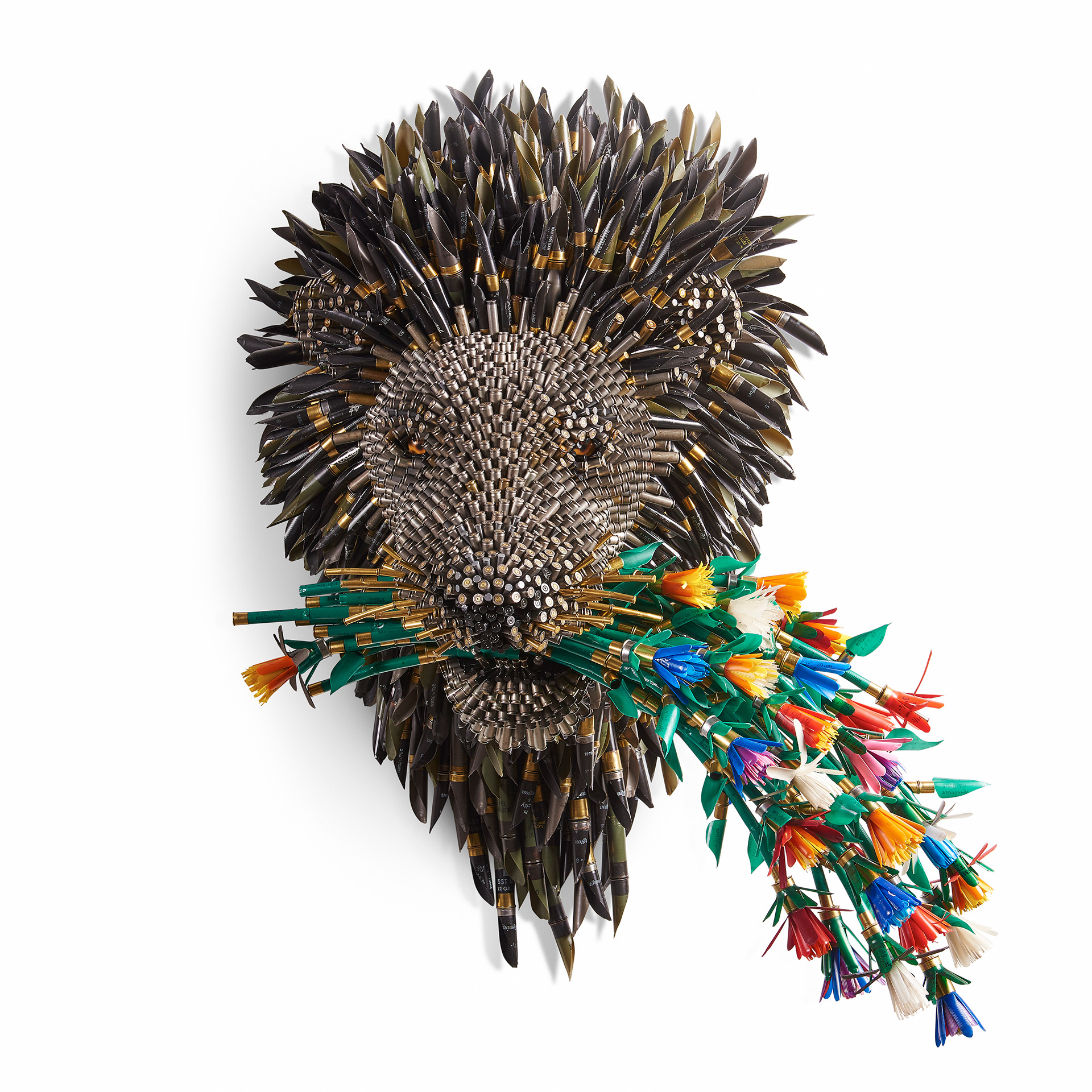
 Exhibition
Exhibition- June 18, 2016 - May 29, 2017
- Kidspace
On June 18, 2016, Kidspace opened Here Comes the Sun, Colombian-born, Miami-based artist Federico Uribe’s magical, colorful, and sculptural menagerie of animals. In tandem, Chicago-based artist Nick Cave wrapped the Kidspace ArtBar in a graphic Kaleidoscopic Playground, a participatory art-making lab inviting visitors to explore their senses, emotions, and self. Both artists shape-shift feelings of sorrow, rage, and despair into positive, immersive environments, with Kidspace becoming a vehicle for dialogue and exploration about the role of joy and optimism. A free opening celebration took place with the artists on Saturday, June 18, from 11am to 1pm.
Optimism might not be the first quality to come to mind when viewing the everyday materials that Federico Uribe repurposes for his animal sculptures. Colorful shotgun casings and golden varying caliber bullets are brought together to form a lion, for example; leather sneakers are arranged into a leaping puma, and an army helmet becomes a turtle’s shell. In an interview, Uribe underlines the irony inherent in his choice of materials: “People kill animals to make shoes; I make animals out of shoes.” One might then think that Uribe intends to alert viewers to the senseless killing of animals. But, instead, Uribe aims to use ordinary and sometimes provocative materials to challenge associations; the goal is against the grain and utopian — or, as he says, to “make people happy” — in spite of preconceived connotations.
Uribe fills roughly 2,000 square feet of space with his majestic animals to create an installation bursting with joy from the moment visitors enter the gallery. Optimism is apparent in Uribe’s mindset, and he expresses it visually as part of his artistic vocabulary, transforming objects from their original (often utilitarian or dangerous) purpose to create an environment that is boldly beautiful.
Director of Education and Kidspace Curator Laura Thompson noted, “I was looking for an artist working with bullets, who could transform them in such a way that reconfigures negative, violent associations and, instead, provides entry points into engaging with challenging topics. A goal of the exhibition is to move beyond the pessimistic, fatalistic, divisive tone of current discourse towards more productive and peaceful communities.”
Nick Cave — building upon the optimism theme — transforms the interactive ArtBar area of Kidspace. Cave is best known for his wearable, sculptural Soundsuits that loosely mimic the bodies of both humans and animals, constructed of materials that include augmented twigs, beads, raffia, feathers, buttons, dyed human hair, and other lustrous materials. While Cave’s art often functions as a pointed commentary on current social issues, his playful, brightly colored works also offer an escape from the same challenges. For Kaleidoscopic Playground, Cave transforms Kidspace into the colorful, metaphorical belly of his acclaimed Soundsuit sculptures through the use of wallpaper of repeated Soundsuit-like graphics.
Visitors can flex their “optimism muscle” throughout the exhibition and further test it at the Kidspace ArtBar in various art-making activities for all ages, including repurposing objects to create new images and sculptures, playing a game-like drawing activity in which visitors are prompted to illustrate certain feelings, and making colorful puppets.
Here Comes the Sun and Kaleidoscopic Playground make up the second component of Kidspace’s Art 4 Change, a four-year project that explores problem-solving through empathy, optimism, and courage. The guiding principle for these exhibition projects is Albert Einstein’s statement that “[we] cannot solve our problems with the same thinking we used when we created them.” In other words, without hope and courage, societal problems can seem overwhelming. In an era of narcissism and cynicism, therefore, an experience with Uribe and Cave’s work provides the opportunity to strengthen our collective sense of optimism, tolerance, and kindness.
The free opening celebration took place on Saturday, June 18, from 11am to 1pm. After the reception at 2pm, musician Dan Zanes inspired with his children’s music at a ticketed concert. Admission to Kidspace is always free; the ArtBar is open on weekends and during school breaks.
Download the Federico Uribe Educators’ Guide here.
Born in Bogotá, Colombia, in 1962, Federico Uribe currently lives and works in Miami. Uribe studied art at the University of Los Andes in Bogotá and, in 1988, he traveled to New York to pursue an MFA degree under the supervision of Luis Camnitzer. After receiving his degree, he left New York to study and work in Cuba, Mexico, Russia, England, and finally Miami. His work has been exhibited at art institutions such as the Chelsea Art Museum, New York, and the Art Museum of the Americas, Washington, DC. He is represented by Adelson Galleries.
Born in Missouri in 1959, Nick Cave studied at the Kansas City Art Institute and the Cranbrook Academy of Art in Michigan, and trained with the renowned Alvin Ailey American Dance Theater. His solo work has been exhibited at the Institute of Contemporary Art, Boston; the Denver Art Museum; and the Peabody Essex Museum, Salem, MA. Cave’s work is included in public collections of the Brooklyn Museum; Crystal Bridges Museum of American Art; the High Museum; the Hirshhorn Museum and Sculpture Garden; the Museum of Modern Art, New York; the Museum of Fine Arts, Boston; and the Smithsonian Institution. Cave teaches at the School of the Art Institute of Chicago and is represented by Jack Shainman Gallery, NY.
Opening Reception
Saturday, June 18, 11am–1pm
Free for all
Join us following the reception for a 2pm concert with Dan Zanes, the crown prince of kids’ music, performing music by folk and blues legend Lead Belly.
Core education funding is provided by the WLS Spencer Foundation.
Education at MASS MoCA is made possible in part by the Institute of Museum and Library Services. Additional support is provided by the National Endowment for the Arts, The Hearst Foundation, Milton and Dorothy Sarnoff Raymond Foundation, Amelia Peabody Foundation, Holly Swett, Feigenbaum Foundation, John Hancock, Massachusetts Cultural Council, C & P Buttenwieser Foundation, TD Charitable Foundation, Berkshire Bank, Price Chopper’s Golub Foundation, the Gateway Fund and the William and Margery Barrett Fund of the Berkshire Taconic Community Foundation, and an anonymous donor. Support for Here Comes the Sun is provided in part by the Adelson Galleries.
The Milton and Dorothy Sarnoff Raymond Foundation gives in memory of Sandy and Lynn Laitman.
Federico Uribe, On Good Faith, 2015
Bullet Shells, 43 x 25 x 26 in.
Courtesy of Adelson Galleries, Boston


